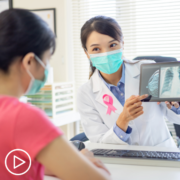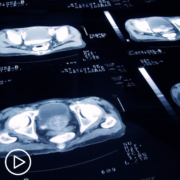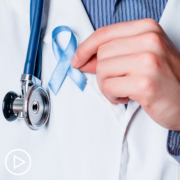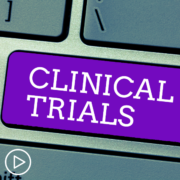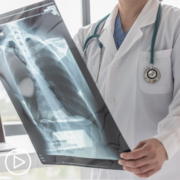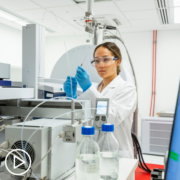What Are the Treatment Options for Early Stage Breast Cancer? from Patient Empowerment Network on Vimeo.
Breast cancer expert Dr. Adrienne Waks reviews available treatment approaches for patients with early stage breast cancer and explains the role of sub types when choosing a treatment plan.
Dr. Adrienne Waks is the Associate Director of Clinical Research at Dana-Farber Cancer Institute. To learn more about Dr. Waks click, here.
See More from Thrive Breast Cancer
Related Resources:
Transcript:
Katherine:
Well, let’s get into the specific treatment options that are available for breast cancer patients. Could you tell us about those?
Dr. Waks:
So, fortunately, the answer to that question is enormous, because we have so many effective treatment options in breast cancer and generally our patients do very well in the long term when they are diagnosed with early stage breast cancer, so stage I or II or III breast cancer.
That might involve the breast, it might involve the lymph nodes under the arm, but it hasn’t traveled anywhere else in the body. So I’ll set aside metastatic breast cancer and just talk about stage I, II, and III.
So, as you may know, we think about as medical oncologists we completely separate treatment considerations for three different subtypes of breast cancer. Those are hormone receptor-positive, HER2-positive and then triple-negative. So, again, highlighting just important developments and not really the overall treatment planning for each of those subtypes, in ER-positive disease or estrogen receptor-positive disease hormonally-driven, estrogen-driven breast cancer – those are all sort of terms for the same thing, I think there have been a couple of important developments over the last few years.
Probably the most important recent one is the new understanding and demonstration that the CDK4/6 inhibitor abemaciclib, the brand name of that drug is Verzenio.
That drug when we administer it for two years after a patient has had their surgery and in conjunction with alongside the antiestrogen medicines; the antiestrogen medicines are usually done for a minimum of five years, when we add on to that the CDK4/6 inhibitor abemaciclib, we see that for women with higher risk disease, so maybe some lymph node involvement or a large tumor in the breast or both that the addition of the Verzenio, the abemaciclib seems to decrease their risk of recurrence of breast cancer a couple of years out. So, that’s been an important exciting development.
Again, not for all women within early stage estrogen-driven breast cancer, but for a little bit more advanced early stage disease like lymph node involvement. You know, we’re obviously always looking for ways to reduce that risk of recurrence for women who have a little bit more risk at diagnosis and the addition of abemaciclib was an exciting and welcome addition to our toolkit there.
In HER2-positive disease, which is about 20 percent of breast cancers overall, I think what the recent years have brought us is increasing understanding that in many cases we give women too much chemotherapy and that we need to be – so, here it’s less about adding on. Like the Verzenio example I was just talking about and more about individualizing and figuring out in whom and how we can pull back from sort of the kitchen sink approach that we take often to treating a HER2-positive early stage breast cancer and be more thoughtful and more personalized in the amount of treatment that we give women with HER2-positive breast cancer.
The reason for that is that we’re basically 20 years into understanding that for HER2-positive breast cancers we can treat those cancers very effectively with anti-HER2 antibody drugs like trastuzumab or Herceptin. We didn’t even know that until 20 years ago. And so, Herceptin, trastuzumab and similar drugs have really revolutionized how effectively we can treat women with HER2-positive breast cancers. And so, at this point, it’s becoming more and more clear that we can really lean more on our arsenal of anti-HER2 targeted therapies like Trastuzumab. Pertuzumab (Perjeta) is another one and trastuzumab MTNC and TDM1 is another one.
So, we have all these excellent smart targeted treatments for women with HER2-positive disease, but yet the standard of care is still to give all those good rational targeted treatments with a whole bunch of chemotherapy that comes with a lot of side effects.
I think more and more we’re figuring out that we can lean more on our anti-HER2 treatments and require less of the really side effect heavy chemotherapy, but how do we do that thoughtfully? We obviously don’t want to undertreat anybody, so how do we do that thoughtfully? How do we pick out the women who only need the anti-HER2 treatment and can get away with less chemotherapy. I think that’s really what’s exciting in HER2-positive early stage breast cancer right is how do we individualize and take advantage of targeted agents that we have?
And then finally, in the third subtype of breast cancer which is triple-negative breast cancer which accounts for about 10 percent of breast cancers, the most exciting development there clearly in the last year or so is the realization and the demonstration in randomized clinical trial that we can improve outcomes for those women if we give them not just chemotherapy but also chemotherapy combined with immunotherapy and specifically the immunotherapy agent called pembrolizumab or Keytruda.
So, up until a year or two ago, the standard for a stage I or II or III triple-negative breast cancer was to get a multiagent chemo regimen and chemo was really the only type of option we had to treat those triple-negative breast cancer patients and now we know from a major important clinical trial called Keynote 522, that if we take a standard chemo backbone and add Pembrolizumab immunotherapy onto it, that we can help those women do better in the long term. So, that’s really a pretty new in the last one or two years standard of care for triple-negative breast cancer.
And I guess the last thing I’ll say is not about one of those three subtypes of breast cancer but specifically for women with a BRCA1 or BRCA2 mutation associated with their breast cancer, which is a minority. It’s about 5 percent of breast cancer patients. Obviously, the proportion changes depending on your subtype of breast cancer and your age when you’re diagnosed, but for women who have a breast cancer associated with BRCA1 or 2 mutation and have a higher risk or early stage breast cancer.
So, again, they have a number of lymph nodes involved or a big tumor in the breast or something like that, we now know that we can add on one year of the PARP inhibitor medication called olaparib or Lynparza to the postoperative treatment of those breast cancer patients in addition to whatever other treatment they got; the antiestrogen pills, the chemotherapy, or a combination of those two, and with the addition of olaparib or Lynparza for a year that we can again see better long-term outcomes for those patients and help them avoid recurrences.
So, that’s not a majority of breast cancer patients but is a targeted treatment that we’re very excited about that definitely makes an important contribution to reducing risk for women with a BRCA1- or BRCA2-associated cancer or men for that matter. I’m saying women, but it could absolutely apply to men.


